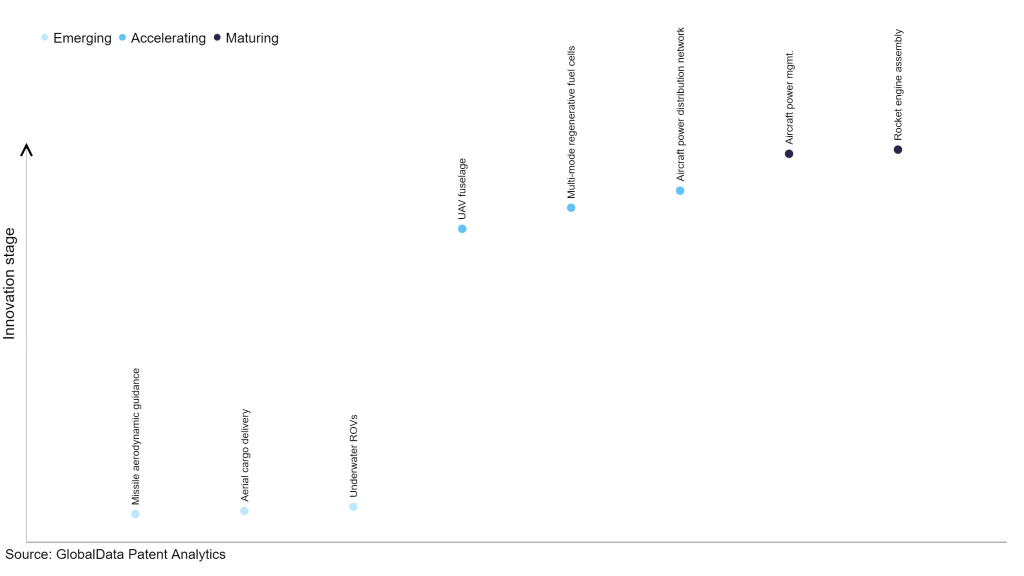The aerospace and defense industry continues to be a hotbed of patent innovation. Activity is driven by the pressing need for modernization and the growing importance of emerging technologies such as artificial intelligence and unmanned systems. In the last three years alone, there have been over 84,000 patents filed and granted in the aerospace and defense industry, according to GlobalData’s report on Innovation in defense: aerial refueling. Buy the report here.
However, not all innovations are equal and nor do they follow a constant upward trend. Instead, their evolution takes the form of an S-shaped curve that reflects their typical lifecycle from early emergence to accelerating adoption, before finally stabilizing and reaching maturity.
Identifying where a particular innovation is on this journey, especially those that are in the emerging and accelerating stages, is essential for understanding their current level of adoption and the likely future trajectory and impact they will have.
110 innovations will shape the aerospace and defense industry
According to GlobalData’s Technology Foresights, which plots the S-curve for the aerospace and defense industry using innovation intensity models built on over 260,000 patents, there are 110 innovation areas that will shape the future of the industry.
Within the emerging innovation stage, missile aerodynamic guidance, aerial cargo delivery, and underwater ROVs are disruptive technologies that are in the early stages of application and should be tracked closely. UAV fuselage, multi-mode regenerative fuel cells and aircraft power distribution network are some of the accelerating innovation areas, where adoption has been steadily increasing. Among maturing innovation areas are aircraft power management and rocket engine assembly, which are now well established in the industry.
Innovation S-curve for the aerospace and defense industry

Aerial refueling is a key innovation area in aerospace and defense
Aerial refueling, also known as in-flight refueling (IFR), air-to-air refueling (AAR) or tanking, involves transferring aviation fuel from one aircraft (the tanker) to another (the receiver) during flight. The two primary refueling solutions are the probe-and-drogue, which can be adapted to various existing aircraft, and the flying boom, which speeds up the process but necessitates a dedicated boom operator station.
GlobalData’s analysis also uncovers the companies at the forefront of each innovation area and assesses the potential reach and impact of their patenting activity across different applications and geographies. According to GlobalData, there are 20+ companies, spanning technology vendors, established aerospace and defense companies, and up-and-coming start-ups engaged in the development and application of aerial refueling.
Key players in aerial refueling – a disruptive innovation in the aerospace and defense industry
‘Application diversity’ measures the number of applications identified for each patent. It broadly splits companies into either ‘niche’ or ‘diversified’ innovators.
‘Geographic reach’ refers to the number of countries each patent is registered in. It reflects the breadth of geographic application intended, ranging from ‘global’ to ‘local’.
Patent volumes related to aerial refueling
Source: GlobalData Patent Analytics
Lockheed Martin is one of the leading patent filers in the aerial refueling domain. Lockheed Martin recently entered into an agreement with Airbus and the US Air Force to manufacture aerial refueling booms for the LMXT strategic tanker aircraft. Israel Aerospace Industries are teaming up with HAL to convert civil passenger aircraft into refueling tankers through the integration of new technologies. Boeing has been researching the unmanned tanker aircraft concept through the development of the MQ-25 Stingray unmanned aerial refueling system. Some other key patent filers in the aerospace and defense industry include Boeing and Airbus.
In terms of application diversity, Boeing is the leading entity, closely followed by ABB and Lockheed Martin in the second and third place respectively. By means of geographic reach, Lockheed Martin holds the top position followed by Israel Aerospace Industries and General Electric.
Aerial refueling capabilities will become increasingly important as the threat of high intensity warfare drives armed forces to become more mobile and expeditionary. Aerial refueling capabilities are being pursued by a growing number of militaries around the globe, with both acquisitions of new tanker aircraft and conversions of existing airframes gaining increased popularity.
To further understand the key themes and technologies disrupting the aerospace and defense industry, access GlobalData’s latest thematic research report on Aerospace & Defense.
Data Insights
From

The gold standard of business intelligence.
Blending expert knowledge with cutting-edge technology, GlobalData’s unrivalled proprietary data will enable you to decode what’s happening in your market. You can make better informed decisions and gain a future-proof advantage over your competitors.



